Asus adds an SSD slot to its RTX 4060 Ti graphics card, delivering up to 12GB/s of SSD performance via the GPU, and the M.2 port even allows using an RTX 4090 as an eGPU
An RTX 4090 piggybacking through an RTX 4060 Ti? Really?
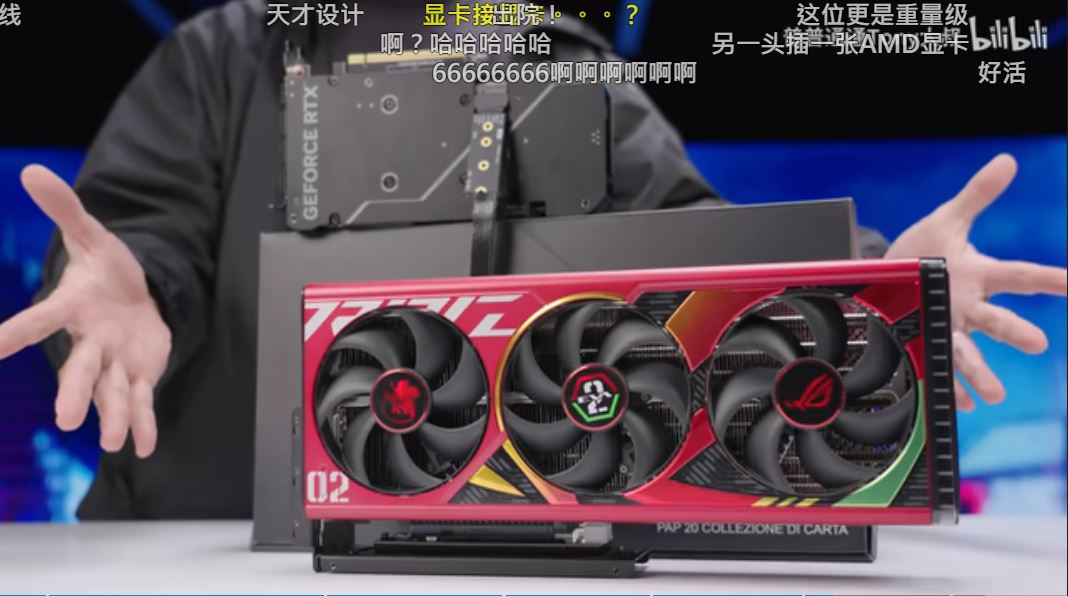
The RTX 4060 Ti isn't one of the best graphics cards, but Asus decided to try to sweeten the pot by adding an M.2 slot to it's RTX 4060 Ti SSD model. Asus took advantage of the RTX 4060 Ti GPU's limited use of the PCIe interface and rewired the PCIe tracing internally to integrate an M.2 2280 PCIe 5.0 SSD slot directly onto the GPU.
This slot is mounted on the back of card's PCB through a backplate cut-out, giving the card a potential leg up on competitors with such a unique feature. The company demoed the new GPU delivering over 12GB/s of throughput from the integrated SSD. What's more, the integrated M.2 port can also host other devices to create new functionalities, such as using an RTX 4090 as an eGPU.
The RTX 4060 Ti only uses eight of the available 16 PCIe lanes. The remaining eight lanes are are physically present but electrically disabled, and Asus has wired up those extra lanes to power the M.2 slot. Despite the RTX 4060 Ti using a PCIe 4.0 interface, as long as the M.2 drive and the motherboard are PCIe 5.0 compatible, the M.2 slot on the GPU can run at full PCIe 5.0 speeds. The Asus RTX 4060 Ti also uses an additional six-pin PCIe power connector to power the M.2 storage, and it's overclockable, with the OC profile giving a 30MHz boost.
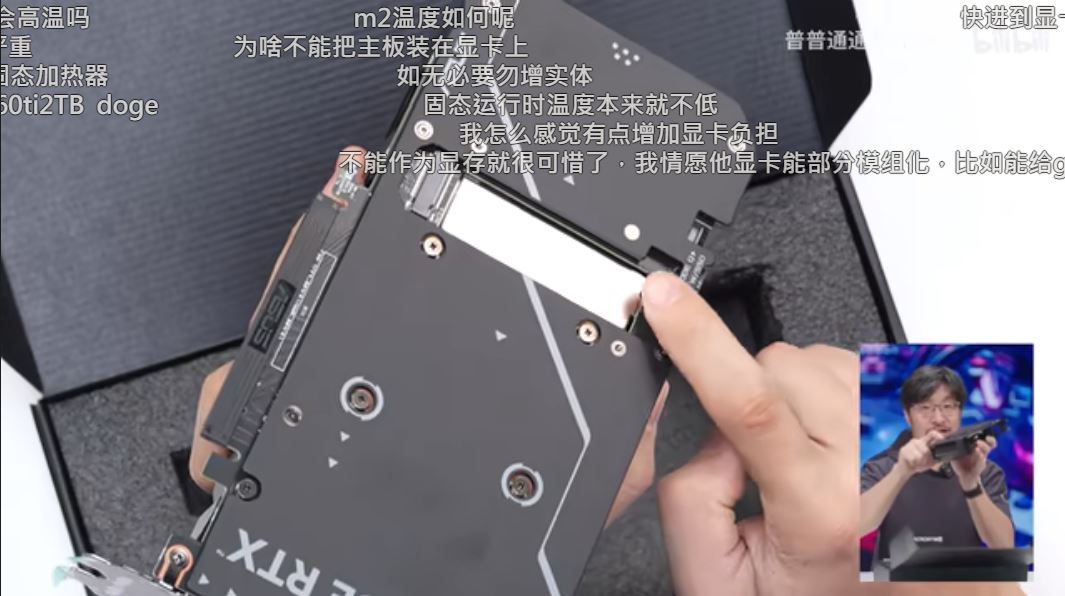
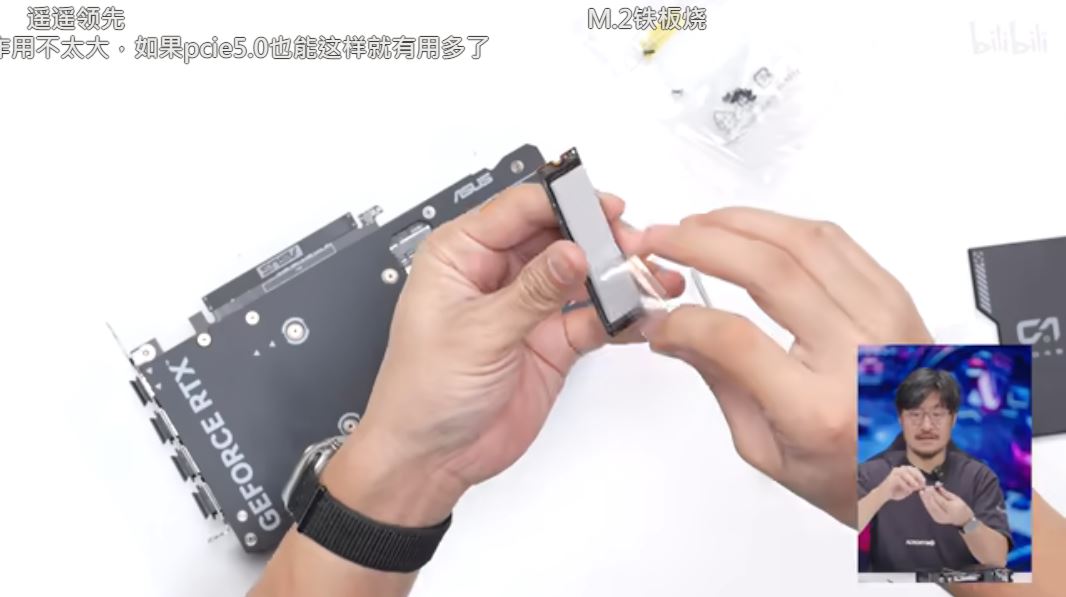

In a prototype demonstration a few months ago, the PCB featured a cutout for the air to blow from the GPU fans to the fin stack and the front PCB area that packs both the SSD controller and NAND chips, but that's not the case with the retail version. While there is a cutout through the GPU's PCB, the M.2 SSD, which has the controller and the NAND chips, will contact part of the GPU heatsink.
Asus's backplate has a large thermal pad pre-installed for the front M.2 drive's PCB, and the GPU comes with two screws and a screwdriver. Installing a bare 2280 SSD — check our SSD benchmarks hierarchy for a rundown of the fastest options — is a straightforward process. But you can also use M.2 to PCIe adapters for some extra functionality.
Tony Yu's Unique Demonstration
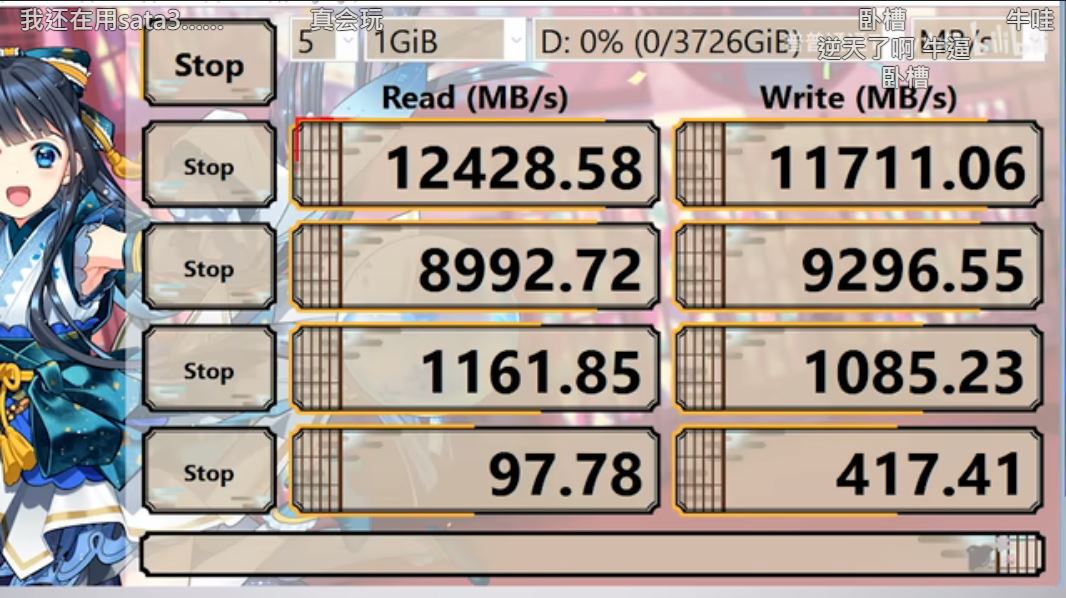
M.2 Performance on Asus 4060 Ti Dual SSD with 4TB Crucial T700 PCIe 5.0 SSD
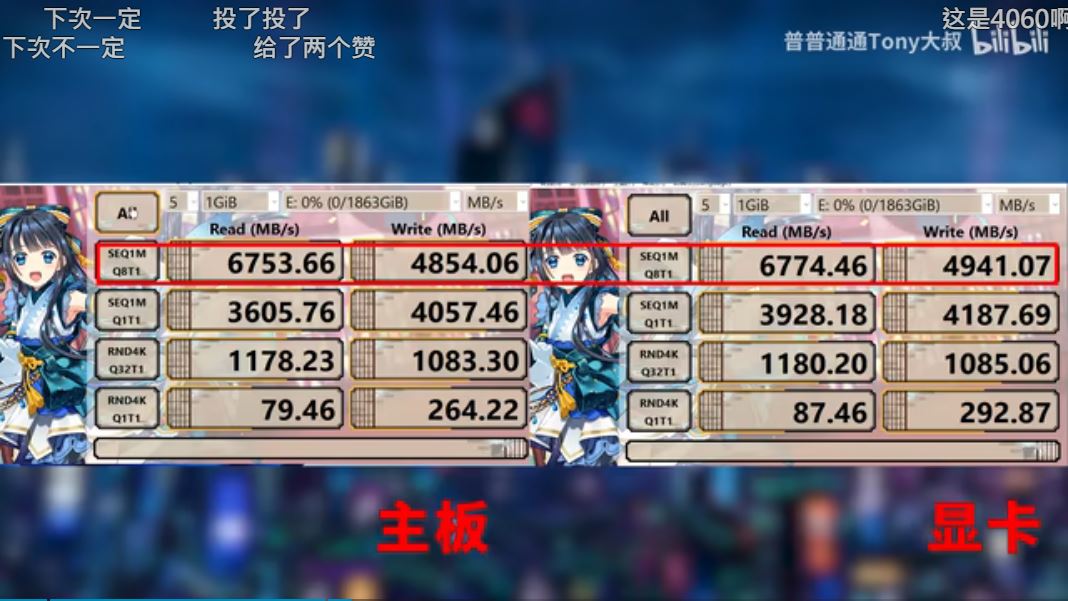
M.2 Performance on Asus 4060 Ti Dual SSD with 2TB Samsung 980 Pro PCIe 4.0 SSD
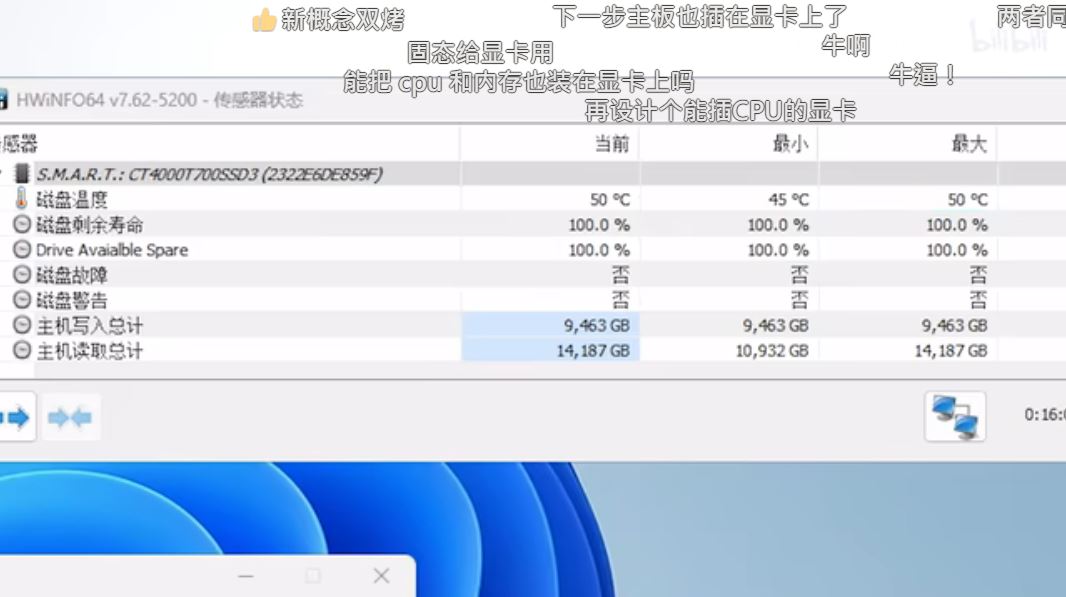
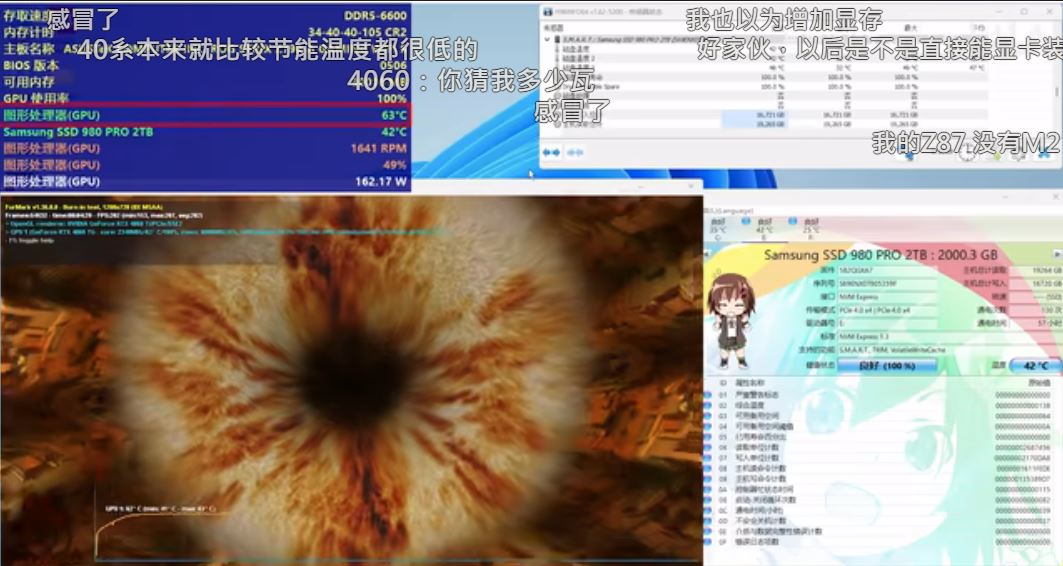
Asus China's product manager, Tony Yu, demonstrated the retail version of the Asus RTX 4060 Ti SSD via China's BiliBili using the Samsung 2TB 980 Pro PCIe 4.0 SSD and the Crucial T700 PCIe 5.0 SSD.
With the Samsung drive running on PCIe 4.0, the GPU delivered 6.75 GB/s of sequential read and 4.8 GB/s of sequential write bandwidth through the RTX 4060 Ti. As thermal performance can make or break the real-world performance for such storage devices, Tony tested the SDS while running the Furmark stress test on the GPU to ensure the graphics cores ran at maximum temperatures. The Samsung 980 Pro 2TB ran at a reasonable 42C while the GPU's Furmark load increased the RTX 4060 Ti's temperature to 63C.
To show PCIe 5.0 performance, Tony demonstrated a 4TB Crucial T700 PCIe 5.0 SSD delivering 12.4 GB/s of sequential read and 11.7 GB/s sequential write throughput, which are the same advertised speeds by Crucial. The SSD ran at 50C during the test.
He also showcased an exotic setup where he paired the system with RTX 4090 connected through the RTX 4060 Ti's M.2 slot via a Gen4x4-to-M.2 adapter. This limits both cards to PCIe 4.0 bandwidth, so the RTX 4090 could only use four PCIe 4.0 lanes via the RTX 4060 Ti's M.2 slot. However, it pulled 75W from the PCIe slot through the M.2 interface.
One might ask about the point of providing an M.2 slot in any graphics card, even if it has enough bandwidth and power throughput to do so. All mid-to-high-end motherboards have had at least two PCIe 4.0 NVMe SSD ports for a while, with the latest chipsets providing a PCIe 5.0 NVMe slot as well. This could be potentially useful for Intel B-series chipsets, as lane splitting is limited to the H770, Z690, and Z790 Intel chipsets. AMD's A620, B450, B650, and X670 meanwhile all support PCIe lane splitting.
Perhaps the best answer to the question of "why?" is simply: Because Asus could. It's probably not practical to have that extra M.2 slot in most cases. But there may be niche scenarios where it could prove useful, among tinkerers and modders in particular. The 4060 Ti still isn't the most exciting of GPUs, what with it's 128-bit memory interface, so adding a unique feature may help Asus move additional units.
The Asus RTX 4060 Ti Dual SSD will of course come at a premium. Currently, the graphics card is not listed for sale anywhere, but we'll follow up with pricing when it becomes available.
Get Tom's Hardware's best news and in-depth reviews, straight to your inbox.

Roshan Ashraf Shaikh has been in the Indian PC hardware community since the early 2000s and has been building PCs, contributing to many Indian tech forums, & blogs. He operated Hardware BBQ for 11 years and wrote news for eTeknix & TweakTown before joining Tom's Hardware team. Besides tech, he is interested in fighting games, movies, anime, and mechanical watches.
-
edzieba Sadly, as this is using Mobo-side PCIe bifurcation support an not an on-card PCIe switch, this means you cannot daisy-chain m.2-equipped 4060Tis ad infinitim.Reply -
epobirs Because nobody ever complained about having too many M.2 slots. Now that higher capacities are becoming affordable, some of us have old but still useful 1TB and 512GB sticks losing their primary storage roles. External enclosures are one way to keep these in use but having more options for internal storage is never a bad thing.Reply